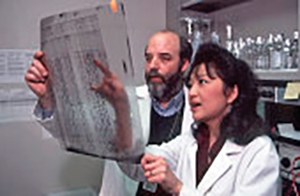
This week we continue our series on Simon & Garfunkel and great New York cancer scientists/researchers. The song “America” starts with the line “Let us be lovers—we’ll marry our fortunes together.” This truly reflects the life story of this week’s scientists, Patrick Moore and Yuan Chang, who met and married as medical students and went on to make medical history. And even more so reflect the American dream, as they have “all come to look for America.”
Yuan Chang was born in Taiwan in 1959 and came to America as a young child, where she was raised in Salt Lake City. She received her MD from the University of Utah and then went to Stanford for training in neuropathology, moving on to be an assistant professor in the Department of Pathology at Columbia University’s College of Physicians & Surgeons in 1993.
Patrick Moore was born in 1956 in Seattle and did his undergraduate work at Westminster College in Salt Lake City, then did a master’s degree at Stanford before going to the University of Utah for his MS and MD degrees. He subsequently obtained a master of public health degree in epidemiology from UC Berkeley. After obtaining his degree in epidemiology, he worked for a while for the Centers for Disease Control before returning to New York City in 1993 where his wife, Yuan Chang, had taken a faculty position. He was initially unemployed, so he worked in his wife’s lab at Columbia and rapidly acquired some research skills in molecular biology and molecular virology.
To appreciate what they achieved, one must see the context of Kaposi sarcoma (KS) at the time. Kaposi sarcoma is a rare malignancy first described in 1872 that is mostly found in elderly Jewish and Mediterranean area men and manifests itself with skin lesions. It is generally highly indolent and with a long survival. It achieved increased prominence with the onset of the AIDS epidemic in 1981 when it became the most common of the AIDS-related malignancies. However, the KS that was now observed in this population was a much more aggressive form of the disease, with the skin lesions more widespread and with metastasis to lymph nodes and visceral organs. Survival was typically measured in months. The main character in the movie “Philadelphia” played by Tom Hanks apparently died from KS.
Chang and Moore began to study KS, the most common malignancy then prevalent among individuals with AIDS and for which no etiologic factor had been identified. They developed a new laboratory technique, known as representational difference analysis, to look for a virus in tissue specimens from patients with KS. In 1994, they discovered a new virus from the herpesvirus family that they called Kaposi sarcoma herpesvirus 8 (KSHV8) in a tumor from a KS patient. They then conducted epidemiologic studies to confirm that this virus was indeed the etiologic agent for KS in AIDS patients, as well as the etiologic factor for another disease, Castleman disease. KSHV8 is one of only seven known human oncoviruses (cancer-causing viruses). By this I mean that the virus itself inserts into the cell and is etiologic. This is in contrast to other viruses which can increase the risk of getting cancer but by external mechanisms, such as hepatitis virus which causes cirrhosis, damage to the liver, which can dramatically increase the risk of primary liver cancer, but the hepatitis virus does not directly cause liver cancer.
In truth, it is not clear exactly how this virus is transmitted among AIDS patients. It may simply be that there is a general endemic prevalence of the virus in the population and that those who are HIV-infected and who develop immunodeficiency on that basis become susceptible to the virus, while those who have intact immune systems remain immune to the virus. Similar immunodeficiency occurs in the context of organ transplant patients (kidney, heart, liver, lung) who are also at elevated risk for KS. Another theory is that saliva passes the virus. It is likely that deep kissing passes the virus.
Moore at this time was given a faculty appointment at Columbia in epidemiology and together, he and Chang went on to sequence the KSHV8 virus.
In 2002, Chang and Moore moved their laboratory to the University of Pittsburgh, where they established a center for the study of tumor virology.
“Kathy,” I said, as we boarded the greyhound in Pittsburgh.
“Michigan seems like a dream to me now.”
It took me four days to hitchhike from Saginaw
I’ve come to look for America…
They’ve all come to look for America.
Alfred I. Neugut, MD, PhD, is a medical oncologist and cancer epidemiologist at Columbia University Irving Medical Center/New York Presbyterian and Mailman School of Public Health in New York. Email: ain1@columbia.edu.
This article is for educational purposes only and is not intended to be a substitute for professional medical advice, diagnosis, or treatment, and does not constitute medical or other professional advice. Always seek the advice of your qualified health provider with any questions you may have regarding a medical condition or treatment.







